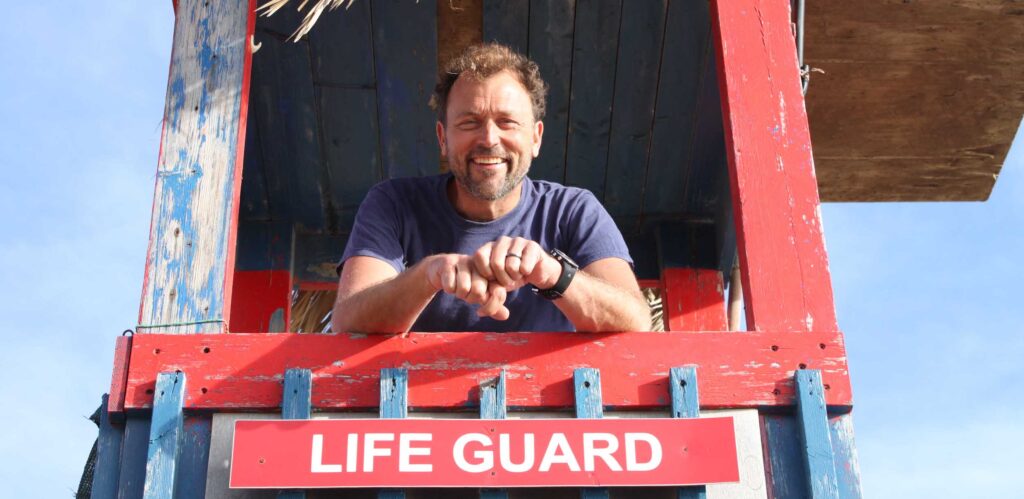
Peter Welcome to our travel podcast. We’re specialist travel writers and we’ve spent half a lifetime exploring every corner of the world.
Felice So we want to share with you some of our extraordinary experiences and the amazing people we’ve met along the way.
Peter This week, we’re talking to wild swimmer Simon Murie. His international company, SwimTrek, takes groups of open water enthusiasts to all corners of the world, all you really need is a pair of Speedos, goggles, a hat and the ability to swim a few kilometres in the warm waters of the Mediterranean or the Caribbean or perhaps a rather chilly North Atlantic Ocean. Simon, really good to have you on the podcast. Firstly, tell us how open water swimming began for you?
Simon My mother was a high board diver; I remember as a kid she used to take me diving. My father was a surf lifeguard from Sydney and they both came over here to the UK. He had a love of open water swimming and my mum also loved swimming in the Thames. So although the the diving didn’t work for me, she persevered with taking me down the Thames in the summer holidays. I remember sitting on the banks of the Thames, she’d have a Radio Times and a picnic blanket and the radio – Radio Four – blasting out all day. And I’d sit next to her with a couple of comics and we’d go swimming in the Thames every hour, next to the fishermen. This was in the 1970s, early 1980s, when open water swimming was definitely not the sort of trendy thing it is now. Anyway, something obviously rubbed off there. So I’d say it’s down to both my mum and my dad that I had this fascination and interest in open water swimming.
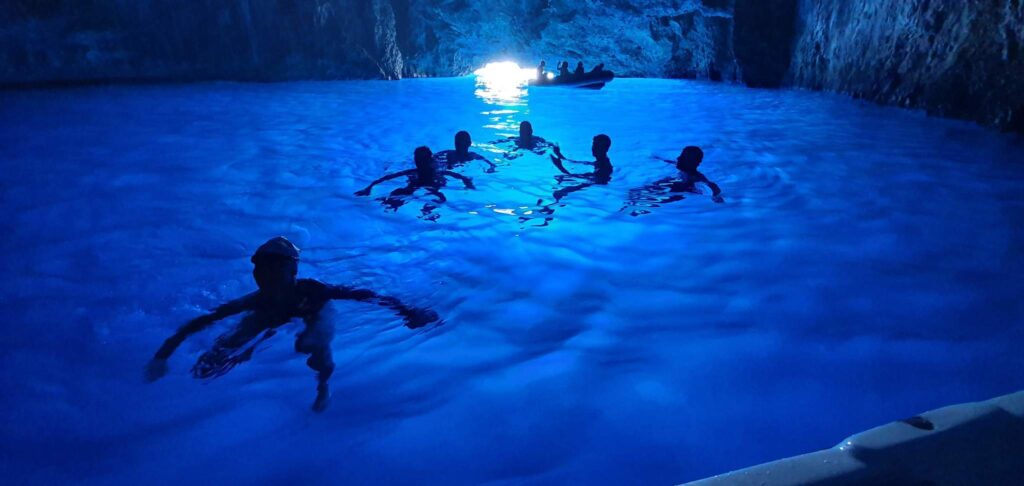
Swimming the Lycian Way, Turkey. Photo: © SwimTrek
I think the first significant swim that got my interest was the Hellespont in Turkey, which was made famous by Lord Byron swimming across it. He actually swam in honour of Leander, who in Greek mythology would swim across the Hellespont with lover, Hero. Hero was on the European side at the castle of Sestos and she would hold out a torch. Then Leander, who was on the Asian side in the castle of Abydos, would swim across. She would hold out the torch, they would do their thing, and then later that night he would swim back. And then one night, a storm blew and Hero’s torch was extinguished and Leander lost his way and was drowned. His body washed up under Sestos Castle and Hero, seeing his body, threw herself off the castle and died alongside Leander. And that was the tragic Greek love story of Hero and Leander.
Byron re-created that swim and, with a Lieutenant Colonel Ekenhead, was the first person to swim the Hellespont. And I remember reading a poem that Byron wrote. I was a mining engineer at the time in northern Nigeria on the border with Niger. I remember reading it as a schoolboy, but then I remember being up in this mine a long way from any water and thinking, ‘What is my passion in life? What do I really enjoy doing?’ And I remember I loved open water swimming, and I always enjoyed finding the most bizarre places to swim. I remember re-reading that poem from Byron and thinking, ‘You know what, when I turn 30 that’s what I’m going to do.’
So when I did turn 30, that’s what I did. I went over to northwestern Turkey and went to the town of Çanakkale and I managed to find a pilot and get various permissions. I needed a military permission, because the Hellespont is also known as the Dardanelles – the famous military campaign of World War I, and it’s straight across from Gallipoli. I needed military permission from the army, but also the navy, and also permission from the coast guard and the town council.
It took me a week to get the permission and find the pilot and about just over an hour to swim it. So that total imbalance of time with the hassle and everything made me think, ‘Well, there must be other people out there who also want to do these fantastic swims around the world, but don’t want to do all the admin, don’t want to do all the organisation and safety support.’ And that was also when my love of open water swimming blossomed, but also the idea behind what I do today which is SwimTrek – which is taking people out on these fantastic swims. So that’s where the idea came from.

Encountering sea life on the Lycian Way. Photo: © SwimTrek
Peter How far across the Hellespont, is it? How many kilometres?
Simon Well, at the nearest point, it’s just a kilometre across from Europe to Asia, but if you headed out from those castles – Kilitbahir is one of the castles, which was fortified during the Dardanelles Campaign in World War I. If you started out from there, you would quickly be washed out into the Mediterranean. So you’ve got to start off a lot higher up. You start off at the town of Eceabat and you get pushed down, as you swim across you get moved down with the current towards the Mediterranean, but also towards the ancient city of Troy. And you end up near where Troy is and you get washed down. So, in effect, you’re probably swimming three and a half kilometres, but the journey you go on is about five kilometres. But you’re probably doing an effective swim of three and a half kilometres across.
Felice Do you have to dodge a lot of boats and things like that on the way?
Simon Well, funnily enough, the day I did it back in 2000, I managed to find this pilot and get the permissions, but the pilot also did say to me, ‘You might have the permissions, but we’re still going to be going off at four o’clock in the morning when the coast guards don’t start their shift till six.’ So we started very early in the morning and literally, I remember waiting off the Asian coast and the pilot just waiting there as he looked up and down the Hellespont, the Dardanelles, to see if there was a break in the traffic.
When there was a break in the traffic, he gave me the signal, as I was standing on the shore, and basically told me to swim, swim, swim. It’s a very busy boat area; this is the same traffic that goes towards Crimea and into the Black Sea in Istanbul, so it’s all those boats going through this very narrow waterway. So yes, we had to get a move on when we saw a break in the traffic.
Peter Having having done this, you then thought there are other people out there who would like to do this without the hassle of organisation. So that’s really how SwimTrek began, was it?
Simon Yes, I think so. I was passionate about going to places and discovering them by swimming. I think what I loved also was this idea of arriving at a landmass under your own steam, and looking back and seeing where you’ve arrived from, so to speak. I think arriving somewhere – and you’ve powered yourself there – makes you appreciate somewhere in a way to somebody, say, who’s arrived by ferry or by boat can’t possibly do.
It’s similar to, say, hiking up Snowdon. Those who’ve hiked up Snowdon and those who’ve arrived on the train, I think appreciate the summit in two totally different ways. I think the same is when you swim from island to island, you’ve immersed yourself in the medium of getting there. I think you appreciate where you’ve arrived so much more than if you got there by plane or by ferry. And that’s where I get my pleasure out of. And I think people who join us also get that sort of pleasure – and also get physically fit as well.
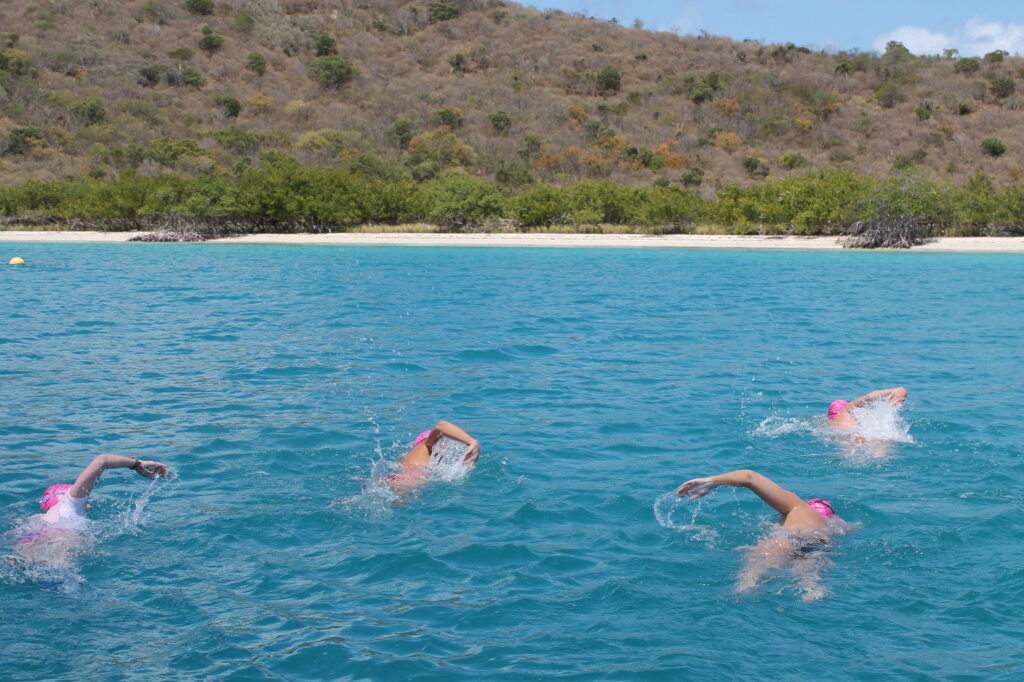
Group swimming. Photo: © SwimTrek
Felice How fit would you have to be to do something like this?
Simon Well, it all depends, really, on the geography of where you are. We started off in the Greek Cyclades, the distance roughly between the islands there…that’s six islands and we island-hop, instead of getting the ferry, we swim. So our strap line at the time was: ‘Ferries are for wimps, let’s swim.’ And that gets the picture across of what we’re doing. But some of the crossings were two to three kilometres and some of the crossings were about 800 metres.
But there will be other places in the Med, in the Caribbean, where the distances are a lot smaller. So they would be more introductory swims, maybe anything between half a kilometre to a kilometre between islands, which is very accessible for a lot of swimmers. Then other islands are much more challenging, like in the British Virgin Islands, where maybe the average distance we’re looking at is three to four kilometres per swim. If somebody is able to swim that average distance in one go before they come on the trip, then we send them out a training plan and away they come. So different trips for different fitness levels, I would say.
Felice So you can’t take anything with you, though – that’s the difference between hiking and swimming?
Simon Yes, that’s true. The more simple, the better. Literally a pair of swimming trunks, goggles and a hat – and that’s all you need in such a simplified pursuit. I think today, when we can get so carried away with the latest Gore-Tex or the latest Neoprene or latest bike that somebody has, I think that simplicity of this sport is something which I’m passionate about. I know lots of other people are as well, and it can be at its core, really basic pursuit.
But what you do have alongside you, or close by, is safety support. So what we tend to do is as we’re hiking maybe to the start of the swim, but before we start swimming, we put our gear, equipment, whatever we need onto the escort boats. They then double as your safety cover as well as taking your gear; you then pick that up when you finish the swim. Safety support’s always there, which can carry your gear. So even though you’re doing it equipment-free, your gear is riding alongside you.
Peter Do you organise flights and all travel arrangements, or do people do that separately?
Simon No, we don’t do the flights. What they do is: people get themselves to the start point, which is generally a hotel on one of these islands or in the location, and people come from all over. I’d say 40% of our clients would be from the UK, 20% from the US, 10% from Australia, and another 10% maybe from Germany, I think that leaves maybe another 10% from everywhere else really. A real nice mix of clientele and people – it’s a really international product.
Peter And as many women as men?
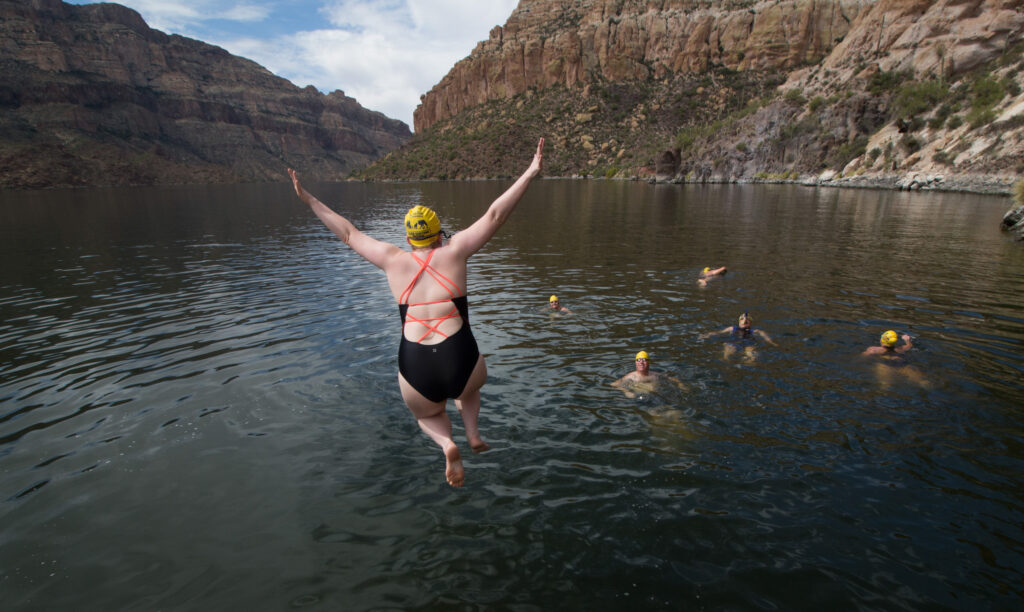
Arizona jump. Photo: © SwimTrek
Simon Yes, I’d say slightly more women than men. Women can achieve at open water swimming just as well as men can. For example, some of the long distance records which are out there have been set by women. So it’s an activity, a pursuit that women are on an equal footing that men are, which is great. Also age-wise, it’s a low impact sport. You think of running, for example, swimming is low impact – the water absorbs a lot of the impact, so actually it’s an activity go on into the late 70s, 80s. We have participants coming in their late 70s, 80s.
Felice You mentioned the Virgin Islands – there must be a danger with sharks and other things in the water?
Simon Yes, I’d say for example, we swim in the Galapagos Islands where we are literally looking for sharks and understanding them and working with the National Park Service on where the sharks are, what their patterns are, and helping us understand them as well. So I would say, touch wood, there’ve never been any issues at all. I think it’s understanding them, and actually in a few locations going to find them and interact with them because they’re incredible creatures.
I think what’s more concerning on our trips is other boat traffic, and that’s why we have our own safety support going alongside them. So it’s actually the manmade stuff that we have to watch out for more, other the boat traffic in the water, and that’s why we always get local permissions but also liaise with other mariners. Actually talking about the Virgin Islands, that swim there from the British Virgin Islands to the US Virgin Islands is great; it’s actually swimming for a reason.
Now, we talked about the Hellespont where you swim for mythological reasons because of Hero and Leander, literary reasons because of Byron, and geographic reasons because you’re actually swimming from Asia to Europe. And all of those reasons are for me the things that make me want to do these swims. So for the Virgin Islands, you’re swimming from British Virgin Islands to the US Virgin Islands…so saying you’ve just come from Britain to America for me is a wonderful way and a reason to get up and actually go and do the swim, as well as some stunning waters, being in a stunning part of the world. The symbolism of it is always an attractive thing for me.
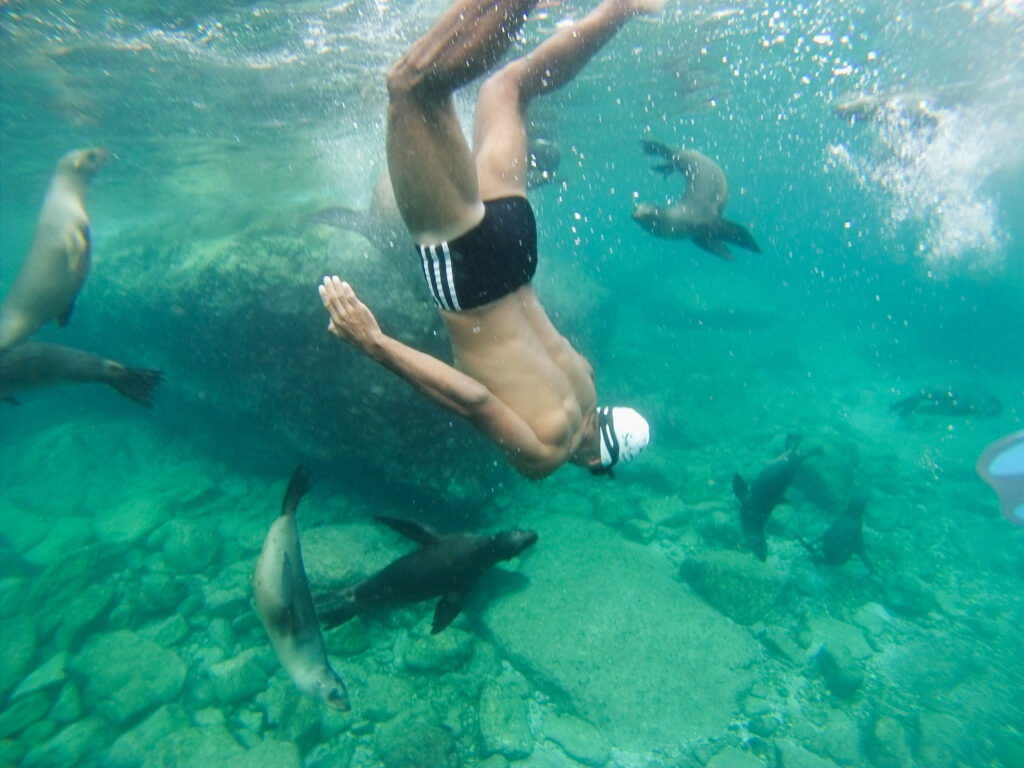
Mexican seals. Photo: © SwimTrek
Peter So how far is it from Britain to America in those terms?
Simon Well, the nearest point is about three kilometres. You can go from Norman Island in the British Virgin Islands across to St John in the US Virgin Islands – that’s about five or six kilometres. But there’s a little island in the middle called Flanagan’s Island, which is part of the US Virgin Islands, and the distance from Flanagan to Norman Island is about three kilometres.
Peter So what’s the longest swim you have personally done?
Simon I’ve done the English Channel back in 2003. Again, there’s significance there, symbolism there, isn’t there? This is Britain’s connection with the rest of the world. It’s the English Channel; it’s been fortified, Britain, I guess. The last successful invasion of Britain was in 1066, so there’s a lot of symbolism there. I think that’s why, for a lot of people that appeals to them to go and swim the English Channel, because it’s significant. And that’s why so many more British people swim the English Channel than French people have swum La Manche, because for us it’s more symbolic and it’s our connection with the rest of the world. For the French, it’s their connection with another island just off their north coast. So that’s why I think for lots of people symbolism is important, and I think that’s why for me I was very keen to do that swim. It’s considered the Everest of swimming, but also it’s Britain’s connection with Europe and the rest of the world. That was the longest swim – it’s twenty-one miles.
Peter And there you are dealing with cold water and jellyfish. Lots of swims that you do and organise are on the chilly side.
Simon For me personally, I love organising swims and putting swims on what I feel I would love to do. And I love the beautiful waters of the Caribbean and the waters of the Mediterranean, but I also love those slightly more challenging conditions of the waters of the Outer Hebrides, for example, and some of the challenges that entails – such as the conditions in the water. You’re always going to get flat conditions; you could get sea swells coming in; you could have your traditional southwesterly wind giving you chop, that can have an effect on the water movements on the surface, which can make the swim more challenging. The wildlife you get there as well, and the water temperature – so all of those challenges for me sometimes makes that swim even more appealing.
So what I like to do is try and offer some of the idyllic swim locations, which generally are more popular and more attractive for people to come and go on. But also, I like to try and offer some of the more ‘out there’ sort of locations you wouldn’t automatically think of swimming, but there will be groups of people who maybe come on the more idyllic swims first, who then think, ‘You know what, the Outer Hebrides that sounds appealing,’ or the Lake District for example, or the backwaters of Oregon, or up in Saskatchewan in northern Canada, going by seaplane, hopping between the lakes up there. They’re not your traditional swimming location, but bringing those in and showing that actually you can have amazing swimming experiences there, is something I love doing.
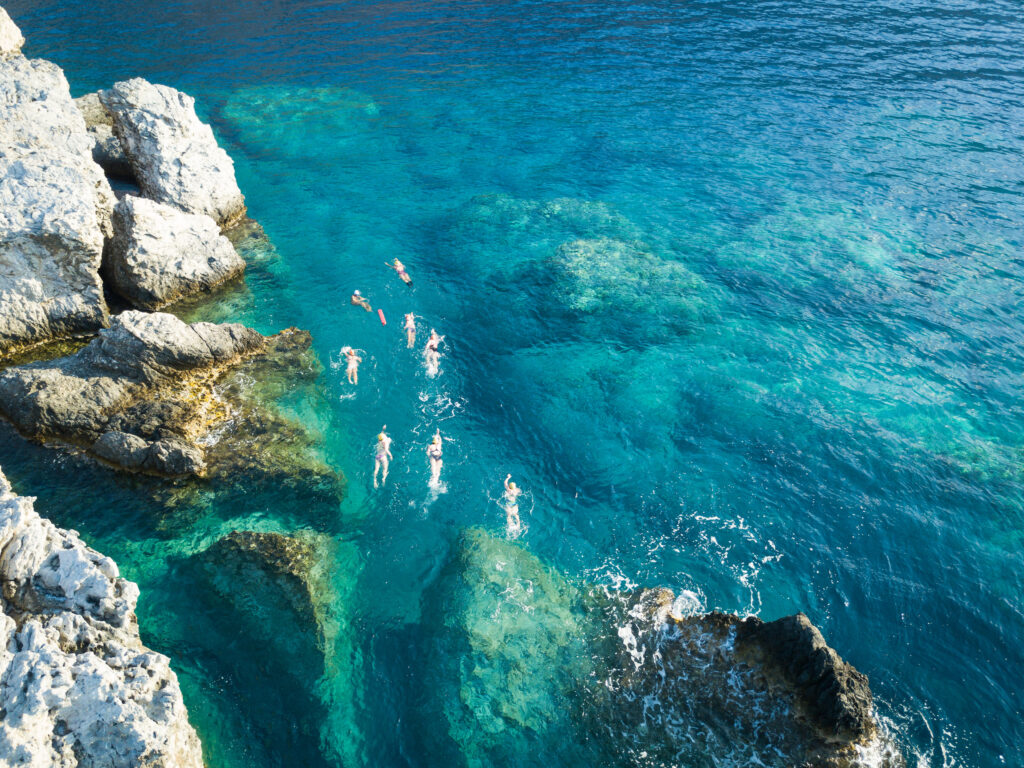
Photo: © SwimTrek
Felice So what would you say the iconic world swims are?
Simon Oh, well, I guess everybody’s iconic world swims varies. For example, in China somebody might think swimming the Yangtze after Chairman Mao would be iconic for them, but it’s not really iconic for anybody else. So I think it’s what is significant for yourself. For me personally, I love significant swims around the world which actually mean something and that are also a bit of a challenge. For example, the English Channel, potentially the Strait of Gibraltar which basically guards the entrance into the Mediterranean but also the divide between Europe and Africa. And also for me actually, one of the attractions is some of these swims dividing continents – that’s what I get excited about.
The Hellespont is another one which divides Europe from Asia. I’d love to go to Iceland, for example, and swim the gap between the North American plate and the European or Eurasian plate, which divides through Iceland. A very short swim, I think, of five or ten metres, so it doesn’t have to be physically challenging. I think finding things of symbolism and significance is what gets me excited.
Peter So you don’t mind cold water? I like to swim something in Greece or someplace. It’s great but I’m not too keen on swimming in the English Channel, let alone the Outer Hebrides.
Simon Yes, I just love the differences. Maybe swimming one week in 30 degree water and then the next you’re swimming in 10 degree water. And I think it’s the changes of conditions and the different challenges that each one of those sets you, that is is something that keeps you coming back for more, I think having the same thing all the time.

Swimming in the Lake District. Photo: © SwimTrek
That’s why I like the British climate. You know, last year or the year before, I was living out in Indonesia and pretty much each day was pretty similar to the next – hot, sweaty which was lovely for swimming; I did some fantastic swims around Indonesia. But the actual British climate of each day is different and the winter is very different from the summer – I find really appealing. I like that in my swimming as well.
Felice Can you still swim if the weather’s very bad?
Simon Well, the good thing about swimming amongst islands is there’s generally always a lee-side, a spot of the island which is out of the wind. So around the Mediterranean, if for example, a bad weather system comes in, you can generally always swim in the sheltered part, which is great. If you’re dealing with one flat coast, it’s very hard then sometimes to get out of that and to actually still have a decent open water swim. So, yes, that’s another reason why swimming around island groups is advantageous.
Peter So for anyone who wants to come on a SwimTrek holiday, presumably there are different grades of swim?
Simon So there’s different grades in terms of the average distance the swimmers are going to be swimming. So it’s one trip might be anything from, say, one to two kilometres a day, up to some other trips might be something maybe five to six kilometres a day. So there’s quite a big variety in swimming distances based on trips. Some other trips will be down rivers – for example, one in the UK, we swim down the River Thames up in Gloucestershire from Letchlade down over a couple of days. So there, even though we’re swimming six to seven kilometres a day, the river’s pushing us down about half of that.
Then on each trip, we’d divide the trip up into fast, medium and slow groups, and each of those groups has their own safety cover. So we might set the slower group off first – or ‘scenic swimmers’, as we like to call them – and they’ll go first with their own safety boat. You haven’t got to feel that you’ve got to either keep up to a particular speed or alternatively slow down to another speed. So you actually swim at your own speed, which is very important and also allows you to enjoy the experience and allows you to swim with other people of your own speed. So the trips are divided, but also within a trip we also divide, so everyone feels at ease and does it at their own pace.

A lake in Lithuania. Photo: © SwimTrek
Felice Do you prefer swimming in the sea to a river or lake?
Simon I love the sea. I love the idea of the salt water on me but I love swimming in various rivers and lakes – I think the feeling I get with lake swimming is the feeling of sweetwater. Saltwater is a very harsh environment; you’d been there for a number of hours, it’s quite abrasive. For saltwater you’re going to swim longer distances, you tend to grease yourself up. In the old days, that used to be using lanolin, the fat from sheep’s wool; these days you tend to use – unless you’re doing a very long distance swim – Vaseline, something like that, and that’s in areas where you chafe. So that might be under your arms, between your legs, on your swimming costume lines. That stops the saltwater from basically having this effect of sandpaper, sort of slightly rougher. Lake water tends to be I like to call sweetwater, but you can you can swim and you can drink as you go – your hydration source, you’re immersed right in it and you just drink it as you go. And obviously, not all lakes everyone’s swimming in I would suggest that, but most of the lakes we go to you can do that. So again, I love that contrast of the more slightly rougher, harsher saltwater and then the sweeter, more gentle freshwater.
Peter So what about jellyfish and swans and other natural hazards you meet along the way?
Simon Yes, they’re all part of the enjoyment and all part of the rich tapestry that is open water swimming. You can compare, say, swimming in a pool to swimming in open water and I would say the differences are you can go to that pool every day for a year, and every day is going to be exactly the same experience. You go into the sea, into a river, into a lake, and every day you swim, you guarantee every day will be a different experience. The tide would be different, the conditions will be different, the weather will be different. Swans, jellyfish, you might get some swans if you’re meandering down the River Cam up in Cambridgeshire and then you also might get jellyfish just swimming in Croatia – and the next day you go down, the swans and the jellyfish might not be there.

That’s what I love about it…every day is different. When you come across swans, always try and find out where the cygnets are and don’t come between the swans and their cygnets. If you can do that, then they generally leave you alone. However, if you’re meandering down and the cygnets are one side of the bank and one of the swans, the mum or dad, is on the other side trying to get food or help building the nest, you might have an issue. So just whenever you see a swan, always just keep an eye out for them, if any cygnets about and don’t go between them because we’ve had some interesting swimming experiences.
Felice We once swam in the Northern Territory of Australia down a river with a guide and he said, ‘Oh, there might be crocodiles here, but, you know, you probably won’t see any.’ And in fact, we didn’t see any. Do you swim in rivers like that as well?
Simon I’ve got a memory – my mum was living out when she was alive, she was out in Ghana. She was doing volunteer work out in Accra and I went to visit her for her 70th birthday. We travelled around Ghana for ten days and we came across the Volta River in eastern Ghana, near the border with Togo. We arrived near the mouth of the river and it was about six kilometres across at this point. And there were these little desert islands, like little stepping stones going across, and then I saw somebody in the water fishing. So I spoke to them and I asked them, ‘What’s the water here like?’
And they said, ‘Well, this is the only part of the Volta you can really swim – this very small section of where these islands are, and there’s people living on all of these islands.’ And I said, ‘Oh yes, why is it?’ ‘Well, it’s just enough salt that the crocodiles don’t come here and it’s just not enough salt that the sharks from the Atlantic don’t come in here.’ So he said there was about this kilometre stretch where these islands were, that actually the locals could go and fish in the water directly rather than have to do it from land.
So then I spoke to him and then he managed to organise me a boat and I ended up hopping island-to-island over the whole day, visiting the island communities on the Volta River and swimming. So that was using local knowledge of where you can swim and where you shouldn’t swim, and actually seeing the locals doing it in action and getting in the water and giving me their advice and copying what they were doing. But instead of fishing, I was just swimming between the islands and hopping across the Volta River.
Peter What about hygiene? I mean, with so many waters polluted these days and plastic in the water. Do you see a lot of plastic in the water?
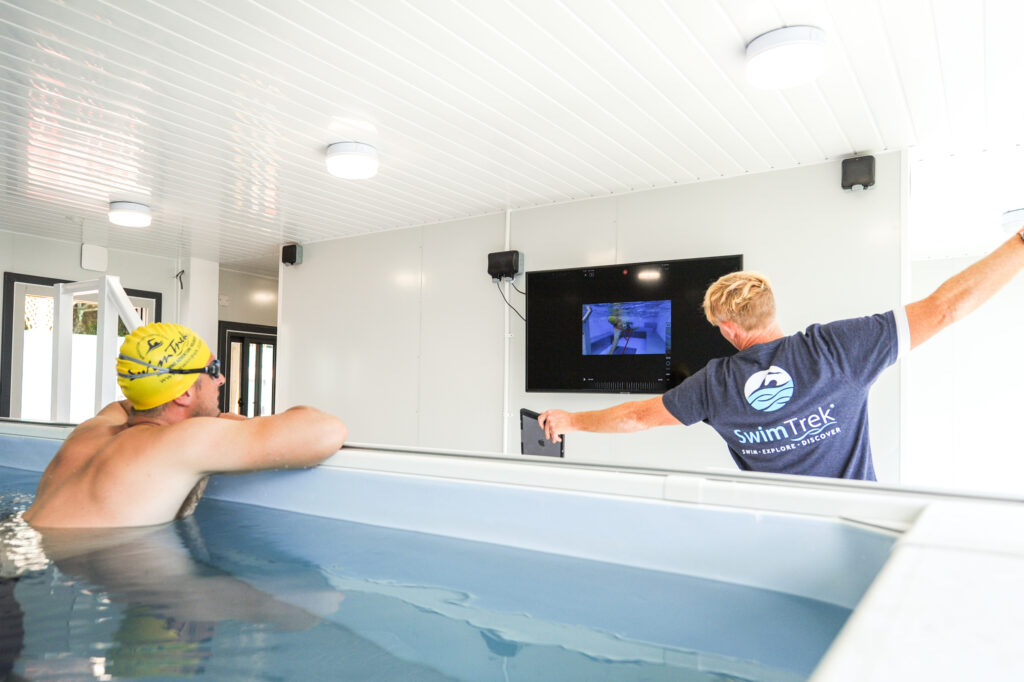
Sea Lanes coaching in Brighton. Photo: © SwimTrek
Simon Yes, I think you need to select your swims based on that. I think there’s a lot more awareness now of environmental issues than maybe when I was first swimming, starting out in the 1970s, early 1980s. Most of the places we swim, we don’t tend to see much rubbish at all, we tend to try and swim in places which are more out of the way and far from the trodden path. But there is definitely an awareness there of environmental issues, and it’s something that we try and work on and try and work with local communities. But even if the local communities are doing their thing, obviously pollution can be affected from far away; it’s a worldwide issue.
Peter Can families come on your trips?
Simon Yes, families can come. We have a few trips open to families as well, where maybe some members of the family want to do these exotic swims and others just can’t think of anything worse. So it’s offering a bit of both. There’s a few locations where we do that as well.
Felice And you also have day trips…I saw to places like Alcatraz? You can just swim there from San Francisco?
Simon Yes, you can go out to Alcatraz and swim back to San Francisco. It’s a relatively short swim, it’s about a kilometre and a half. And talking about symbolism, that’s an iconic swim and a fantastic crossing. The water temperature gets down to about 16 degrees Centigrade, 61 degrees Fahrenheit, and that’s a wonderful swim. A little tidbit of information: Alcatraz was the only prison in the US prison system that gave their inmates hot showers rather than cold showers. Any idea why?
Peter None at all.
Simon Well, the reason was if they did manage to escape out of Alcatraz, when they got to the water they wouldn’t be acclimatised to the water temperature to swim across. That was the reason why they only had hot showers there. So one thing was doing the swim and obviously understanding what the tides and currents were like, but the other thing was being acclimatised to the water. So they basically gave the inmates as little ability to be able to get across as possible. But yes, Alcatraz is a trip you can do in a few hours, really.
Peter I think I’m right in saying that I’ve read that no one ever escaped by swimming?
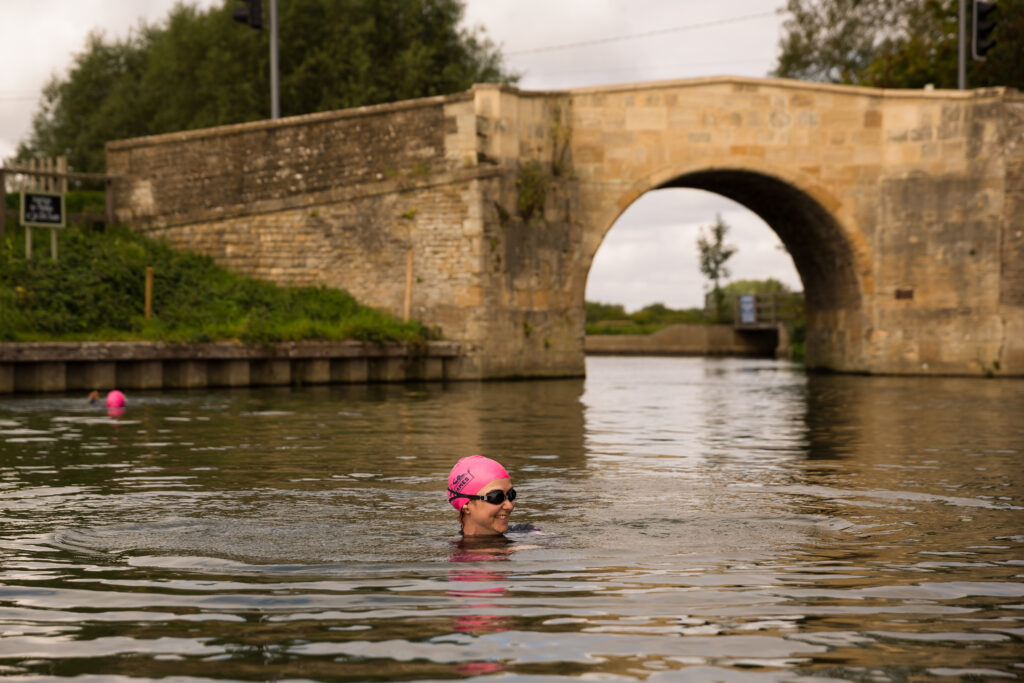
Swimming the Thames. Photo: © SwimTrek
Simon Well, there was three inmates disappeared after escaping and they don’t know what happened to them. Nobody knows. There was a movie written about it, books written about these three inmates who escaped the prison and disappeared from the island but no one knows if they actually escaped or what happened to them.
Felice For some tamer one-day swims, you’ll take people along the Thames and things like that?
Simon Yes, we do lots of short one-day trips along the River Thames, which is lovely, a lovely meander. Some lunch on the riverbanks and we do some walking along the Thames Path as well. Then we also do another half-day swim up in Scotland across the Corryvreckan Whirlpool, which is the third biggest whirlpool in the world, but it’s only a whirlpool at certain times of the tide. We swim across it when it’s slack water, where there isn’t a whirlpool but what is nice is to go and see it when the whirlpool is full flow and a full turbulent broth of calamity, and then see what the boats have to put up with when they go through it. And then the next thing is maybe three hours, four hours later is to see the whirlpool nice, flat, calm, and swimming across it. So the Corryvreckan is another one-day, half-day trip that we offer, which is a little bit more straightforward, but it’s a beautiful swim between Jura and the island of Scarba.
Felice So at the moment are you still swimming?
Simon Yes, I was swimming a bit in the sea at Brighton where I’m based, ready to go as all our guides are when we’re able to get out and about again. We’re number one in the UK – we have a lot of UK guests, but we also have a lot of US guests. So I think our first focus is trips within the UK and trips within the US and then hopefully at some stage trips overseas as well, which we’re really looking forward to getting back into.
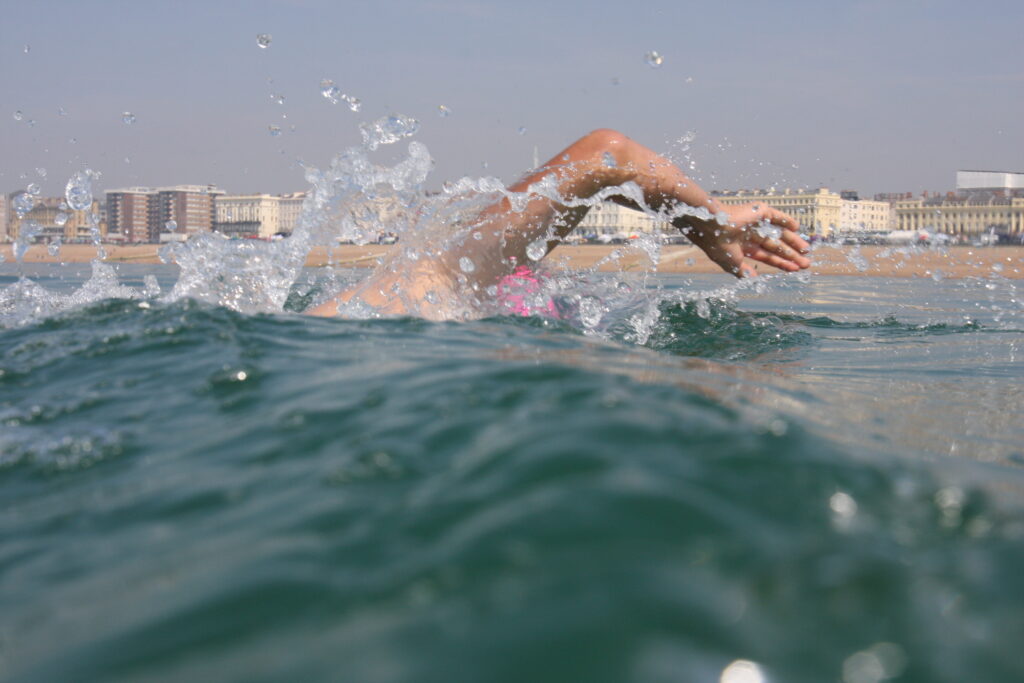
Brighton swim. Photo: © SwimTrek
Felice Has anything ever gone really wrong on any of your swims?
Simon No, not really, touch wood. The only thing I remember was on my first ever trip we ran in the Greek Cyclades back in 2003. We were on about our third island we’d swum two islands and we were staying in different accommodation on each island. The third island we got to was an island called to Koufonisia off the south of Naxos, and we swam there – a big swim of about three and a half kilometres – and we arrived. We then hiked across the island, arrived at the hotel, pretty tired., everyone was pretty exhausted. We had a journalist from the Saturday Times on the trip. I learned from that: never take a journalist on your first trip to a particular location. We arrived at the hotel, exhausted and met the hotelier who I had met two weeks earlier, had met quite a few times, exchanged emails, phone calls, everything good, had the rooms booked.
She came out and said, ‘What are you doing here? I’ve given all your rooms away.’
I said, ‘What?’
‘Well, you didn’t arrive on the ferry and the only way you can get to the island is arriving on the ferry.’
I said, ‘Well, no, I explained to you we were swimming here.’
She said, ‘I thought you were just swimming off the beach.’ So the next two hours was spent sitting in the foyer of the hotel, watching these forlorn people come out who basically were getting evicted from their rooms by the hotelier.
Not that it particularly went wrong, but it wasn’t a great start to our first ever trip. But anyway, from then we made sure that we described to our suppliers and our hoteliers exactly what we were doing. But no, touch wood, I think that having the safety cover right there. It’s not like climbing a mountain – where you’re climbing a mountain and you’re pretty much are on your own; it might be very hard to get medivaced out from anywhere if you do have issues at altitude. But here, as I’ve said, we do have safety going very closely alongside with qualified lifeguards looking after you as you go. So, again, if there is any problem, swimmers get out onto the boats and can have a cup of tea on the boat, watch what’s going on and then maybe join the swim again or just have a rest.
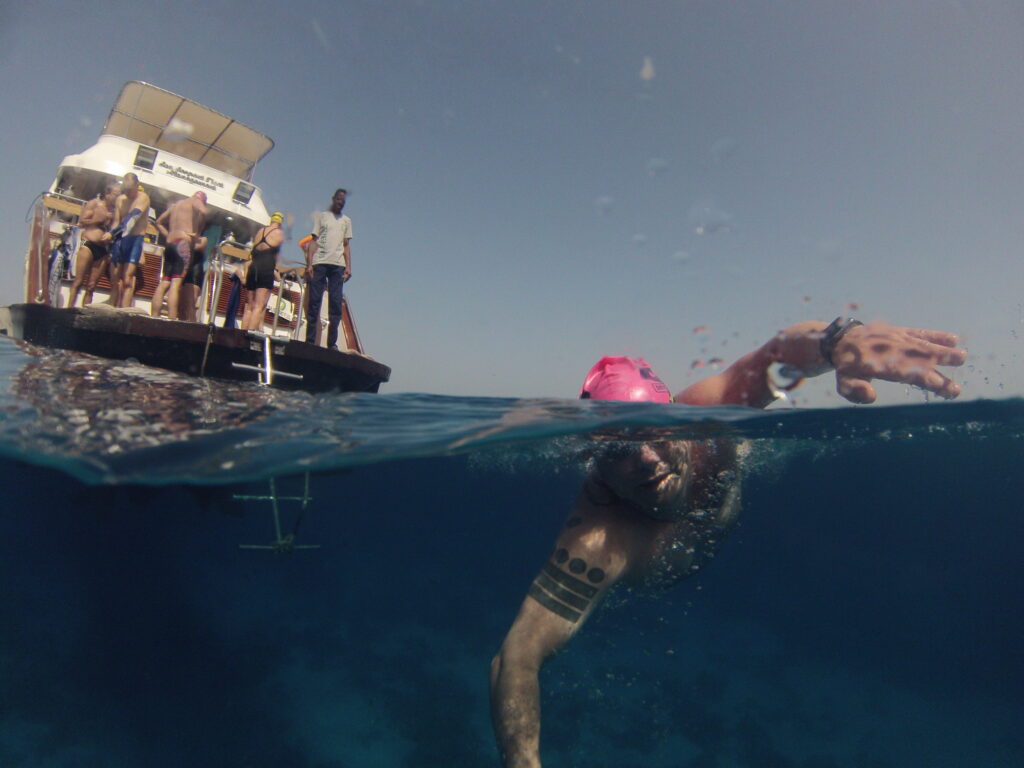
Photo: © SwimTrek
Peter So how big is the boat? How many people can it take?
Simon It will take groups between 10 and 15 swimmers. So the main boat will take all of those swimmers with lots of space to stretch out. Then we’ll have a couple of inflatable boats with outboard engines who will also look after some of the other groups. So if you want to get out, you then get taken out on one of the boats and make your way back to the main boat where you can relax. That takes the whole group, so to speak.
Felice If people want to find out more and book a trip with you, what’s your website called?
Simon The website is SwimTrek.com. All the information’s there of all the trips that we do, whether it’s from the Galapagos Islands off South America all the way to the Outer Hebrides in Scotland and everything in between, there’s something to entice any swimmer, also any person who finds swimming enjoyable and enticing and wants to discover more. So any questions, give us a shout.
Peter Simon Murie, thank you very much for appearing on Action Packed Travel and we wish you the very best of luck in the future with SwimTrek.
Simon Thank you very much, Felice. Thank you very much Peter as well.
Felice That’s all for now. If you’ve enjoyed the show, please share this episode with at least one other person! Do also subscribe on Spotify, i-Tunes or any of the many podcast providers – where you can give us a rating. You can subscribe on Spotify, Apple Podcasts or any of the many podcast platforms. You can also find us on Twitter, Facebook and Instagram. We’d love you to sign up for our regular emails to [email protected].
© ActionPacked Travel
![]()
- Join over a hundred thousand podcasters already using Buzzsprout to get their message out to the world.
- Following the link lets Buzzsprout know we sent you, gets you a $20 Amazon gift card if you sign up for a paid plan, and helps support our show.



